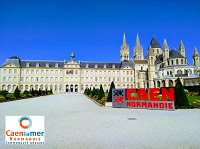Présidents de session
Transport model simulations of heavy-ion reactions
- Akira Ono
Transport model simulations of heavy-ion reactions
- Wolfgang Trautmann
Heavy-ion collisions and their interpretation by transport model simulations can make a significant contribution to the study of the nuclear EOS, complementary to nuclear structure studies, astrophysical observations and microscopic many-body calculations, since they allow to control to a wide extent the thermodynamical conditions and give information on the composition of the system, in...
The formation of nuclear clusters, which emerge as many-body correlations at sub-saturation densities in nuclear matter, is essential for constructing a reliable equation of state (EOS). Phenomenological models utilizing energy density functionals (EDFs) provide a convenient approach to account for these bound states of nucleons by introducing clusters as additional degrees of freedom (DOF)....
Is it possible to combine a quantum mean-field theory and molecular dynamics within a unique framework for heavy-ion collisions?
Starting from the time-dependent Hartree-Fock scheme and by introducing a dynamical basis of orthogonal fermionic wave functions, we work out a solution to combine the advantages of the two above-mentioned approaches, bypassing a number of usual approximations....
Authors: S. Glässel, V. Kireyeu, G. Coci, V. Voronyuk, M. Winn, J. Aichelin, C. Blume, and E. Bratkovskaya
We present the latest results on the constraints on the equation-of-state (EoS) of strongly interacting hadronic and partonic matter created in heavy-ion collisions from study of the light clusters, hypernuclei and strange hadrons (hyperons and strange mesons). Our study is based on ...
The equation of state of nuclear matter, momentum dependence of the optical potential and in-medium modification of elastic nucleon-nucleon cross-sections have been previously studied by comparing theoretical predictions for collective flows and stopping observables in intermediate energy heavy-ion collisions to experimental data gathered by the FOPI Collaboration[1]. The study is extended to...
In heavy-ion collisions at several hundred MeV/nucleon, a compressed nuclear system is formed to about twice the saturation density and then rapidly expands. It has been a theoretical challenge to extract information about nuclear matter properties such as the EOS of isospin-asymmetric nuclear matter. Since light clusters and heavier fragment nuclei are abundantly produced, they can influence...
An overview of challenges and perspectives offered by correlation measurements at facilities with beams over E/A=100 MeV will be presented. Focus on observables and possible multi-purpose setups, including strategies for using transport model simulations are key for the advance of our community engaged in the study of nuclear matter under extreme conditions and its implications in the most...

